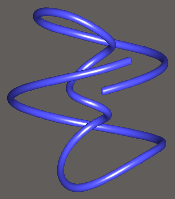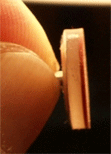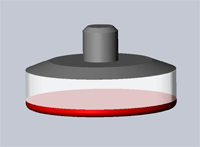
|
Produkte
|
|
Quarz-Resonanz-Polster (QRP)
Sie bestehen aus drei Schichten:
Im Unterschied zu geschäumten Silikonen halten diese Polster ihre Form über Jahre und Jahrzehnte, ohne sich nach und nach dem Zwirl anzuschmiegen. Dadurch garantieren sie einerseits konstante Resonanzeigenschaften, andererseits wird das bei herkömmlichen Polstern mit zunehmendem Alter auftretende Kleben und Schmatzen sowie das damit verbundene lautere Aufschlag-Geräusch vermieden. Deshalb erlauben wir uns, fünf Jahre Garantie auf das Material und die Verklebung zu geben. Aufgrund dieser langlebigen Materialeigenschaften werden diese Polster bei späteren Generalüberholungen auch nicht ausgetauscht. Das garantiert über lange Zeit eine Konstanz der gewohnten Instrumenteneigenschaften und macht Überholungen dazu noch erheblich kostengünstiger. QRP sind nicht im selben Maße anschmiegsam wie Lederpolster oder ähnlich weiche Synthetik-Polster. Sie benötigen deshalb für eine einwandfreie Funktion plane, scharfkantige und saubere Zwirle. Nicht alle Instrumente bringen a priori diese Voraussetzungen mit, weshalb es sich empfiehlt, vor der Verwendung von QRP alle Zwirle auf diese Eigenschaften hin zu prüfen oder nachzuarbeiten. siehe auch >>Fachbegriffe/QRP |
Quartz-Resonance-Pad (QRP)
Quartz-Resonance-Pads (QRP) are special pads produced for the application in clarinets and oboes. But they can also be used in the smaller keys of the other woodwind instruments like the register and trill keys of bassoon and saxophone. They were developed specifically for a better and permanently constant resonance level of woodwind instruments. They consist of three layers:
Therefore quartz-resonance-pads feature several properties:
Optimal tightness is achieved by the red surface layer together with the balancing damping layer. On the other hand the red silicone is so firm, that it nearly doesn’t cave in, so that there is no problem with sticking. This firmness is caused by the component of 24% quartz flour (that’s why we describe this material as “elastic glass”) which is also responsible for the very good resonance properties in consequence of the optimal reflection of sound waves. The impact damping is fulfilled by the flexible and soft transparent silicone. This material also ensures the “phase compensation” between tone-hole (vibrating body) and key (that’s what felt is doing in conventional pads. Unfortunately the felt has not only the effect of “phase compensation” but also sucks and deletes all the frequencies almost completely). That’s why the QRP already have an enormous effect when they are only attached in the upper keys of an instrument (especially a more direct and faster response). The QRP-materials are in contrast to foamed silicone inherently stable and last for many years. So they can remain in the instrument and need not to be changed in the course of a general overhaul. |

 Quarzresonanzpolster (QRP) sind bei uns im Hause hergestellte Spezial-Polster für Klarinetten und Oboen, aber auch für die kleineren Klappen anderer Holzblasinstrumente (z. B. Schleifklappen beim Fagott, Überblasklappen und Triller des Saxophons). Sie wurden von uns speziell für eine bessere und dauerhaft konstante Resonanzlage von Holzblasinstrumenten entwickelt.
Quarzresonanzpolster (QRP) sind bei uns im Hause hergestellte Spezial-Polster für Klarinetten und Oboen, aber auch für die kleineren Klappen anderer Holzblasinstrumente (z. B. Schleifklappen beim Fagott, Überblasklappen und Triller des Saxophons). Sie wurden von uns speziell für eine bessere und dauerhaft konstante Resonanzlage von Holzblasinstrumenten entwickelt.